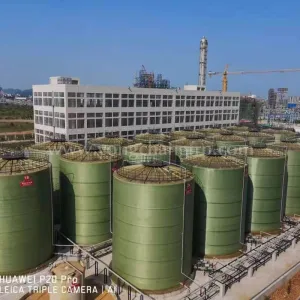How does FRP tank work?
Fiber Reinforced Plastic (FRP) tanks have gained widespread acceptance across various industries due to their durability, corrosion resistance, and versatility. These tanks find applications in storing a wide range of liquids, chemicals, and gases.
**1. Composition of FRP Tanks:
FRP tanks are constructed using a composite material made up of fibers embedded in a polymer matrix. The fibers, commonly glass or carbon, provide strength and rigidity, while the polymer matrix, typically epoxy or polyester resin, binds the fibers together, forming a robust and corrosion-resistant structure.
**2. Corrosion Resistance:
One of the primary advantages of FRP tanks is their exceptional corrosion resistance. The composite material is inert to a wide range of chemicals, making FRP tanks suitable for storing corrosive substances without the risk of degradation or material deterioration.
**3. Mechanical Strength:
The fiber reinforcement imparts significant mechanical strength to FRP tanks. This strength allows the tanks to withstand both internal pressure from stored liquids and external loads such as wind or seismic forces. FRP tanks can be designed to meet specific strength requirements based on the intended application.
**4. Lightweight Design:
Despite their robust mechanical properties, FRP tanks are relatively lightweight compared to traditional materials like steel. This characteristic makes them easier to transport, handle, and install, reducing overall construction and logistical costs.
**5. Thermal Insulation:
FRP tanks exhibit excellent thermal insulation properties. This insulation helps in maintaining consistent temperatures within the tank, making them suitable for applications where temperature control is critical, such as in chemical processing or water treatment.
**6. Non-Conductive Material:
Being a non-conductive material, FRP tanks are well-suited for storing substances that may be sensitive to electrical conductivity. This property makes them ideal for applications involving electrical components or where the stored material must be isolated from external electrical influences.
**7. Manufacturing Process:
The manufacturing process of FRP tanks typically involves the following steps:
Design: Engineers design the tank based on the specific requirements of the application, considering factors such as capacity, dimensions, and structural specifications.
Mold Creation: A mold is created based on the tank design. The mold determines the shape and dimensions of the tank.
Layering: Layers of fiber reinforcement (such as glass mat or woven roving) are laid into the mold.
Resin Application: The chosen resin, usually epoxy or polyester, is applied to the fiber layers. This process is known as wet lay-up or hand lay-up.
Curing: The entire structure is allowed to cure, allowing the resin to harden and bond with the fibers, forming a solid composite structure.
Finishing: The finished tank is trimmed, inspected, and, if necessary, coated for additional protection or aesthetic purposes.
**8. Applications of FRP Tanks:
FRP tanks find extensive applications in various industries, including:
Chemical Processing: Storing corrosive chemicals and acids.
Water Treatment: Holding potable water or wastewater.
Petrochemical Industry: Storing fuel and other hydrocarbons.
Agriculture: Irrigation and liquid fertilizer storage.
Food and Beverage: Storing food-grade liquids.
**9. Maintenance and Longevity:
FRP tanks are known for their low maintenance requirements. Regular inspections and cleaning may be necessary to ensure optimal performance and longevity. With proper care, FRP tanks can have a service life of several decades.
In summary, FRP tanks operate by leveraging the unique properties of fiber-reinforced plastic. Their composition provides corrosion resistance, mechanical strength, and thermal insulation, making them suitable for a diverse range of applications across industries. Understanding the manufacturing process and the advantages of FRP tanks allows industries to make informed decisions when selecting storage solutions for their specific needs.
540
0
0



Comments
All Comments (0)